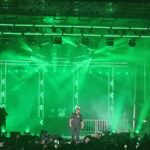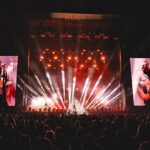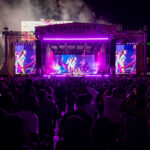Lighting Co
Lite Alternative (UK)/Upstaging (US)
Venue
Various (Tour)
Crew
Lighting & Set Designer: Rob Sinclair
Lighting Director: Matt Arthur
Lighting Techs: Mike Sheppard, Rob Starksfield (UK), Mike Ponsiglioni (US)
Tour & Production Manager: Colin Davies
Stage/Set Co: Hangman Ltd.
Trucking Co: Fly By Night (UK)/Upstaging (US)
Gear
1 Jands Vista S1 Console w/ Mac laptop control & 2 M1 wings
19 Martin MAC 700 Profiles
8 Martin MAC 101s
8 Martin Atomic Strobes
8 Color Kinetics ColorBlaze 72
11 ETC Source Four 750W Profiles
7 James Thomas Linear 4-Lites
6 James Thomas Square 4-Lites
4 Floor Cans
1 Custom Illuminated Strangeland Sign
2 Reel EFX Diffusion DF-50 hazers & fans
2 Truss sections (40ft)
4 Manfrotto stands (for Source Fours)
Designer Perspectives
By Steve Jennings
Rob Sinclair (Lighting Designer)
“Keane’s new record is less ‘poppy,’ and the band wanted their presentation to reflect that, so for this tour I made some of the cues more edgy. We had some ups and downs at the start, but I think we’ve got it. The [Martin] MAC 101’s work really well as tight sidelights. They’re small, bright and cheap — all good attributes. Other than that, no surprises. The system needs to be reliably replicated all over the world, and so it’s good to stick to something achievable and flexible.
Matt (Arthur) is a lovely man and also a great LD in his own right. He’s the ideal person to take a show like this around the world for a year and, in the process, change it to make it better and take ownership of it. Keane are one of my longest-standing clients, and it’s always a pleasure to work with them. They all have great eyes and give fabulous input as well as let me know what they don’t like, which makes my job easier.”
Matt Arthur (Lighting Director)
“As far as the overall design goes, Rob (Sinclair) pretty much takes the reins. He meets with the band and management and discusses their feelings and thoughts on the direction of each tour design. He’ll start submitting renders of his design concepts for feedback. This tour was nailed on the second round of renders, which is pretty good! I’ll make some suggestions to certain things, but not very often, as Rob is pretty much “all over it” as far as putting together a good looking set and lighting design to work off. I get involved later.
The brief for this latest outing, Strangeland, was an Art Deco feel and a lot, if not all, of the inspiration for the backdrop, illuminated sign and chandeliers (which unfortunately, due to freighting costs, didn’t make it to the U.S. on this run), came from the local theatre in the bands hometown, called The De La Warr Pavilion. My involvement really starts once the design has been signed off.
Once signed off, I go ahead with the initial discussions with the lighting company about gear and control solutions. I kind of end up as a technical director to start with. As Rob was with us on the first few shows, he did all the initial programming. I ran through the show with my wysiwyg computer, to get an idea of cueing and looks. Then I sat with him for these three shows at The De La Warr, and we discussed certain elements about structuring and looks of certain songs. It has to be said that I was meant to run at least two of these three shows, but Rob was having such a good time running these shows after a long absence he couldn’t let it go. He then stepped away fully and I took over in mid-March, and my process of fine-tuning it began. Rob popped back into the first of our two shows at Brixton Academy (the last of the UK/ EU tour). We programmed all day, he saw the show, and left me a bunch of notes to take away to the U.S.
For the UK/ Europe legs, we use Lite Alternative out of Blackburn, Paul Normandale’s company. I do a lot with them as a freelancer, too. In fact, my association with Keane is because of Lite Alt. I went out as lighting crew in 2007 and lighting crew chief in 2009. This is the tour cycle that I finished for Rob as he went off to do Peter Gabriel. I’ve been involved ever since. Keane has been a long-term client, so Jon Greaves and Andy Scott always bend over backwards for us. We took full production out on these legs. In the USA, it’s Upstaging. Again, long term relationships via this and other tours that I and tour management have been involved with, and always very accommodating.
For the U.S. leg, it’s a little different. We take a full lighting / control package out on the road, but no truss or motors. We use house trusses or fly bars, so each venue is a little different, depending on the configuration of flying and where we get the line sets or the trusses. It works really well, actually, as I advance each venue individually, so I know what we are walking into. On the U.S. leg, all production was out in one hour, 15 minutes…so it works well.
Coming into our production rehearsals mid-May, management suggested that the show needed to be simplified, as it was a bit “too clever,” and that the older songs looked the same as other tours….which, to a certain extent, they did! So through rehearsals, I went about implementing these changes and generally putting a bit of my own stamp on it. Of course, some of the clever bits were returned, but in a different guise to still give the song some animation, I changed around the older songs too. This is where Rob left me to it. It’s been great re-doing those ones!
I’ve been using the Vista lighting console for a while now, since around 2007, and V1 software. Rob was the one who showed it to me the first time on that particular Keane tour. I was in the market for a new console that I could possibly purchase and have with me all the time. I got this setup in 2011.
The popular ones at that time weren’t really doing it for me. I saw the Vista, and the visual layout really appealed to me. You can see what’s going on all the time. The patch is a simple drag-and-drop method, so you can see exactly what addresses are occupied. It’s really helpful to spot any mistakes. The fixture exchange, with the generic fixture model, works consistently well. Admittedly, now it’s much better than it was, but still, it has always been great.
In V2 Byron, the fixture editor allows you to create a fixture, which is very helpful ‘in the field.’ You can build your own, provided you have the fixture personality info, of course! It’s got me out of a mess a few times. The feature I have fallen in love with recently, as I have been editing a lot, is the timeline. I finally got to grips with it. Again, you can see exactly what each fixture is doing in all parameters with times. So if something is weird, you can see why. Insert commands are really helpful too. Alias cues are cool, a great tool for verse / chorus songs.
Overall, I like the portability of the setup. My setup of a laptop, S1 and 2 x M1s plus all the bits fit inside a Peli. I have a medium sized flight case that it travels in most of the time. I’ve got a monitor and general things in the case also. But if it’s a fly gig, I just take the Peli and off we go. Also, as it’s software-based, I can edit on planes, hotel rooms, and in minivans if necessary!”
For more Keane Strangeland tour photos by Steve Jennings, go to www.plsn.me/extrakeane.


